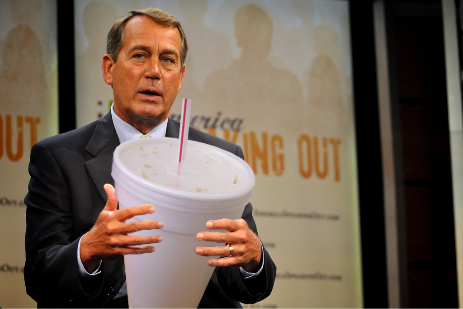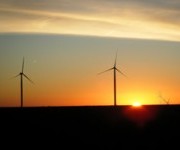 This past weekend, I attended the Aspen Institute‘s Clean Energy Roundtable, an annual gathering of business, political, and policy leaders working in clean energy. Inspired by the many insights and ideas presented, here are my thoughts on the state of clean energy today and what lies ahead.
This past weekend, I attended the Aspen Institute‘s Clean Energy Roundtable, an annual gathering of business, political, and policy leaders working in clean energy. Inspired by the many insights and ideas presented, here are my thoughts on the state of clean energy today and what lies ahead.
First, the good news. Prices of key clean energy technologies are plummeting, bringing many technologies, such as distributed solar and energy storage, closer and closer to mass deployment. The cost of solar panels today is about 20 percent below that of a year ago. And it should continue dropping for the forseeable future. In other words, the performance/price ratio is improving exponentially, like computer chips, if not quite as fast, and for different reasons — cost economies for the most part, as opposed to breakthrough technologies. The main driver of the plummeting costs is volume and successful efforts by the Chinese government to vertically integrate the Chinese solar industry, which now supplies over half of the world’s solar panels. (In advanced thin films, costs per watt are also coming down.) Even more dramatic price drops are occurring in battery storage across a range of chemistries, with prices halving in the the last year. Plummeting prices that translate to rising performance are good news for developers, electric carmakers, and the global industry at large.
The story is more complicated, however, in the United States, where we are in what might be described as the best and worst of times. This past year saw torrid growth in solar deployment in the U.S., with solar capacity doubling; wind installations also grew, and wind is now a very competitive source of power. Solar — already competitive with subsidies — will be competitive without them in several years. That is the good news. The bad news is that solar generation still supplies only 0.2 percent of U.S. electricity, and, what’s more, growth has been driven by the 1603 provision in the tax law that allows tax credits to be redeemed for cash. This provision expires on Dec. 31 this year. Since the financial crisis, tax credits deals to build everything from affordable housing to energy have exceeded the relatively thin pool of capital from investors seeking to shelter profits. That means tax credits absent the 1603 provision can be worthless. With extension of Section 1603 uncertain, the solar industry may face significant challenges beginning this winter.
Similarly, on the wind side, the end of the 1603 credit would take a toll, and the production tax credit for wind itself expires at the end of next year. While companies are scrambling to start projects before these deadlines pass, afterwards activity may fall of the proverbial cliff. In short, while global fundamentals for clean energy remain strong, the sector remains quite sensitive to government subsidy. In the U.S., with subsidy likely to change, and especially with gas prices likely to stay low as more shale gas comes onstream, we may see more clean energy activity shift overseas. (One potential fix to this problem: moving clean energy off “subsidies” and giving them equal access to the master limited partnership tax break that extractive industries like oil and gas enjoy.)
Indeed, despite intense focus by Silicon Valley and the support of the U.S. government, the U.S. is not catching up with Europe or China on clean energy, and in many measures, we are falling further behind. A few years ago, Germany adopted an export promotion plan that included factories as exports. It exported gas turbine and solar panel factories to China, which is how China has so rapidly come to dominate many areas of clean manufacturing. The Germans have done well selling machine tools to the Chinese while creating demand (and green power) at home through an aggressive feed-in tariff. The U.S., however — except for a few bright spots like Applied Materials, which makes equipment to manufacture panels; First Solar, a thin film manufacturer; a few innovators such as Sun Edison and Tesla; and a few large companies such as GE and IBM — has yet to find its way.
Why? Unlike Germany, which has deep credentials in improving manufacturing incrementally, we have excelled through innovating and creating new industries. For example, France Telecom deployed the minitel years before America went online, but U.S. companies ultimately came to dominate online technology once we created the open internet platform that allowed Yankee entrepreneurship to flourish. Yet despite developing scores of breakthrough energy technologies in our national labs and robust funding of clean energy companies, as I have written before, cleantech innovators have run up against the brick wall of a regulatory system that funnels purchasing decisions to regulated utilities. The latter are disincentivized by law to invest in new technologies. Meanwhile, in many states, the consumer remains locked out of the action entirely behind the Iron Curtain of the electricity meter. The sector is still attracting capital, but time is running out to upgrade the regulatory structure to what I have described as Electricity 2.0 to create large, gatekeeper-free platforms that reward innovation and investment.
If there is one strong positive on the clean energy front, it is that the consumer has been given a small seat at the table, notably through the introduction this year of the first two electric cars, the Chevy Volt and the Nissan Leaf, and in the form of the proliferation of direct generation of electricity, primarily from solar. The electric car is a technology that can engage the consumer on the ultimate playing field of new, more, and better. However, if the the cars fail to thrill, cleantech will experience a potentially huge setback. For that reason, making electric cars and charging infrastructure work has to be a key priority for the industry.
More broadly, the once-almighty American consumer, who has not only driven domestic growth in recent decades by controlling a huge chunk of GDP, but also funded the development of the Pacific rim, has been the missing force in the clean energy sector. Consumers are prohibited from directly buying clean energy by law in many states, in contrast to communications or the internet, where consumer demand drives rapid product life cycles and profits at a speed in sync with venture capital.
Indeed, the write-once, make-money-everywhere model of the internet is providing stiff competition for capital to cleantech, where local regulations and the gatekeeping role of utilities can sap the energies of even the best funded, most visionary entrepreneurs.
Nonetheless, my final takeaway was that while challenges abound, clean energy remains one of the largest, most important, and potentially most transformative projects of the 21st century. Our job is to engage the consumer, sweep away barriers, and play to America’s strengths in innovation, entrepreneurship, and out-of-the box thinking in the face of obstacles.




